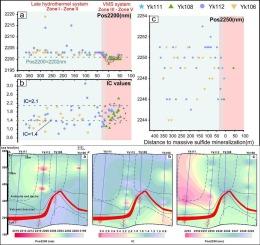Alteration characteristics and short wavelength infrared (SWIR) spectroscopy of the Huangtupo Cu-Zn VMS deposit, NW China: Implications for ore genesis and exploration
IF 3.6
2区 地球科学
Q1 GEOLOGY
引用次数: 0
Abstract
The Huangtupo Cu-Zn deposit is a typical Early-Paleozoic volcanogenic massive sulfide (VMS) deposit situated in Eastern Tianshan, within the Central Asia Orogenic Belt. Based on the paragenetic sequence reflected by mineral assemblages and their textural characteristics, the alteration and mineralization processes at Huangtupo can be categorized into two major periods comprising eight distinct stages: the VMS period (including the premineralization stage S1, stockwork ore stage S2, massive sulfide ore stage S3, and barite stage S4), and the late hydrothermal overprinting period (encompassing the albite stage S5, silicification stage S6, chlorite + epidote stage S7, and carbonate stage S8). By correlating petrographic investigation and short-wave infrared (SWIR) spectral analysis, five alteration/mineralization zones have been distinguished along the vertical profile, characterized by: Zone I (albite-white mica-chlorite zone), Zone II (albite-white mica-chlorite-epidote zone), Zone III (chlorite-pyrite ± white mica zone), Zone IV (massive sulfide zone), and Zone V (pyrite-quartz-white mica zone). Alteration and mineralization features indicate that Huangtupo is a highly overprinted sub-seafloor replacement VMS deposit.
SWIR spectrometry shows that chlorite and white mica are the primary alteration minerals in Huangtupo. For white mica, the position of Al-OH absorption feature (Pos2200) exhibits a spectral shift between 2198 and 2214 nm which is interpreted to reflect a compositional trend spanning from paragonite towards phengite. The illite crystallinity (IC) values of white mica vary from 0.79 to 3.11. For chlorite, the position of Fe-OH absorption feature (Pos2250) ranges from 2241 to 2253 nm, indicating Mg-rich to Mg-Fe chlorite compositions. Proximal to massive sulfide mineralization, white mica exhibits shorter Pos2200 (wavelengths below 2202 nm) and higher IC values (1.4–2.1). Additionally, chlorite near the ore body is typically predominantly Mg-rich (wavelengths below 2250 nm), though no significant spatial variation pattern is observed. These findings suggest that white mica formed under high-temperature, acidic conditions near massive sulfides, while chlorite formation was likely influenced by Mg-rich seawater infiltration. The alteration mineral assemblage in the hanging wall may reflect subsequent overprinting by porphyry-like hydrothermal fluids. This study highlights the coexistence of VMS and porphyry-type mineralization potential at Huangtupo, providing a valuable case for SWIR applications in ancient sub-seafloor replacement VMS systems.

黄土坡VMS铜锌矿床蚀变特征及短波红外光谱特征对矿床成因及找矿意义
黄土坡铜锌矿床位于中亚造山带的东天山,是一个典型的早古生代火山岩块状硫化物矿床。根据矿物组合反映的共生序列及其结构特征,将黄土坡蚀变成矿过程划分为两大期,分为8个阶段:VMS期(包括预成矿S1期、网状矿S2期、块状硫化物矿S3期和重晶石S4期)和后期热液套印期(包括钠长石S5期、硅化S6期、绿泥石+绿帘石S7期和碳酸盐S8期)。结合岩石学调查和短波红外光谱分析,在垂直剖面上划分出5个蚀变/矿化带,分别为:ⅰ区(钠长石-白云母-绿泥石带)、ⅱ区(钠长石-白云母-绿泥石-绿泥石带)、ⅲ区(绿泥石-黄铁矿±白云母带)、ⅳ区(块状硫化物带)和ⅴ区(黄铁矿-石英-白云母带)。蚀变和矿化特征表明,黄土坡是一个高度叠印的海底替换型VMS矿床。SWIR光谱分析表明,绿泥石和白色云母是黄土坡主要蚀变矿物。对于白色云母,Al-OH吸收特征(Pos2200)的位置在2198 ~ 2214 nm之间发生了光谱位移,反映了其成分从paragonite向云母过渡的趋势。白云母的伊利石结晶度(IC)值在0.79 ~ 3.11之间。对于绿泥石,铁- oh吸收特征(Pos2250)的位置在2241 ~ 2253 nm之间,表明绿泥石成分为富mg ~富Mg-Fe。在块状硫化物矿化附近,白色云母表现出较短的Pos2200(波长小于2202 nm)和较高的IC值(1.4 ~ 2.1)。此外,矿体附近的绿泥石通常以富镁为主(波长低于2250 nm),但没有观察到明显的空间变化模式。这些发现表明,白色云母形成于高温、酸性条件下,靠近大量硫化物,而绿泥石的形成可能受到富镁海水渗透的影响。上盘蚀变矿物组合可能反映了斑岩类热液的后续套印作用。该研究突出了黄土坡VMS与斑岩型成矿潜力共存的特点,为SWIR在古代海底替换VMS系统中的应用提供了有价值的案例。
本文章由计算机程序翻译,如有差异,请以英文原文为准。
求助全文
约1分钟内获得全文
求助全文
来源期刊

Ore Geology Reviews
地学-地质学
CiteScore
6.50
自引率
27.30%
发文量
546
审稿时长
22.9 weeks
期刊介绍:
Ore Geology Reviews aims to familiarize all earth scientists with recent advances in a number of interconnected disciplines related to the study of, and search for, ore deposits. The reviews range from brief to longer contributions, but the journal preferentially publishes manuscripts that fill the niche between the commonly shorter journal articles and the comprehensive book coverages, and thus has a special appeal to many authors and readers.
 求助内容:
求助内容: 应助结果提醒方式:
应助结果提醒方式:


